Case report
A 62-year-old male patient was admitted as a result of a motorcycle accident. He was found 20 metres from his motorcycle after a probable collision with a deer. The unconscious but haemodynamically stable patient was intubated for airway protection. No cardiac murmur was heard on initial physical examination. The ECG on admission showed sinus rhythm with a diffuse myocardial ischaemia pattern. The cardiac enzymes were slightly elevated with a troponin I of 0.12 ug/l (norm <0.05 ug/l), which was interpreted as in line with a contusio cordis. Except for a pulmonary infiltrate in the left inferior lobe, computed tomography of the chest revealed no pathological findings. The cranial computed tomography showed neither skull fractures nor intracerebral bleeding. X-ray of the right forearm disclosed a Monteggia fracture which was treated surgically. During this operation a growing need for haemodynamic support emerged. Due to a remarkably high blood pressure amplitude and a further rise in cardiac enzymes, urgent transthoracic echocardiography was performed, which showed a slightly dilated left ventricle with preserved left ventricular function and severe aortic regurgitation. Transoesophageal echocardiography revealed a rupture of the non-coronary cusp of the aortic valve (Figure 1, Figure 2, Figure 3, Figure 4 and Figure 5). Aortic dissection was ruled out.
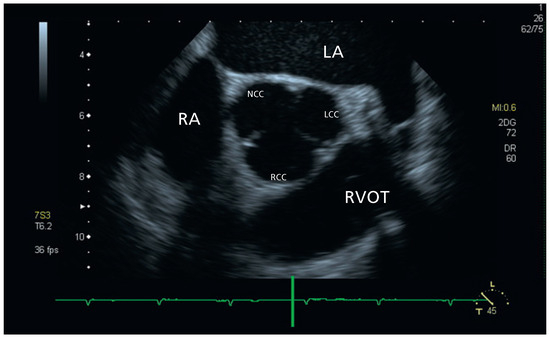
Figure 1.
Diastolic frame of the aortic valve in short axis TEE view showing no major pathological changes.
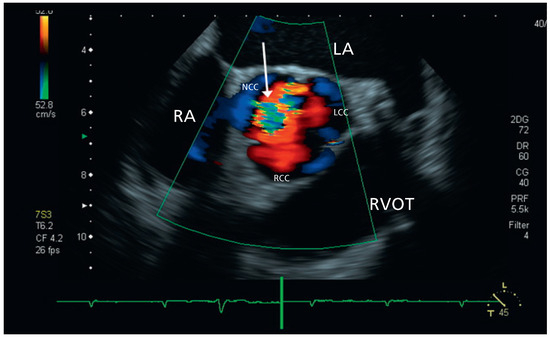
Figure 2.
Diastolic frame of the aortic valve in short axis TEE view with colour Doppler showing significant aortic insufficiency (arrow) in the region of the non-coronary cusp.
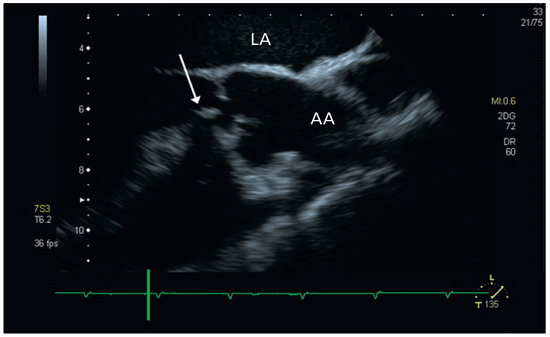
Figure 3.
Diastolic frame of the aortic valve and the aorta in long axis TEE view showing prolapsing non-coronary aortic cusp into the left ventricular outflow tract (arrow).
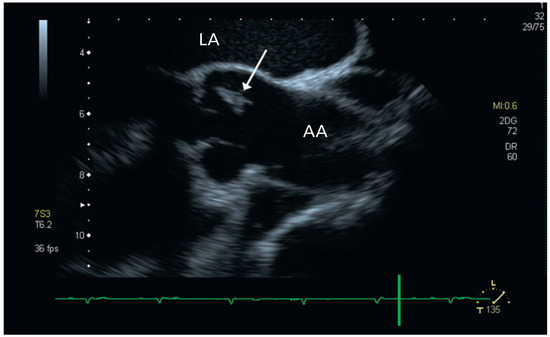
Figure 4.
Systolic frame of the aortic valve and the aorta in long axis TEE view showing failing non-coronary aortic cusp (arrow).
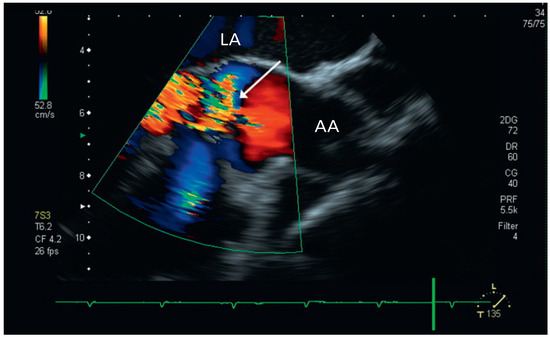
Figure 5.
Diastolic frame of the aortic valve and the aorta in long axis TEE view with colour Doppler showing severe aortic insufficiency (arrow).
In addition to the severe aortic regurgitation coronary angiography showed three-vessel disease. The patient was transferred to cardiac surgery (Figure 6), where aortic valve replacement with a bioprosthesis and a triple coronary bypass operation were performed. After cardiac surgery the patient recovered well and was discharged in good health on day nineteen.
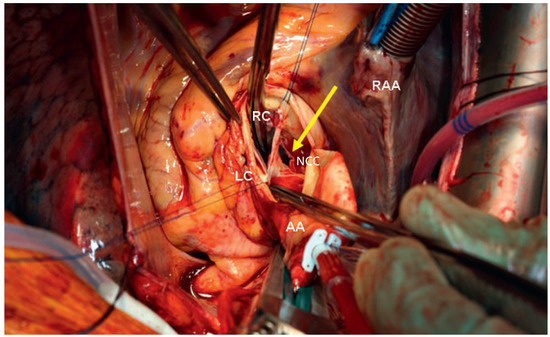
Figure 6.
The intraoperative view of the aortotomy and the tricuspid aortic valve; An approx. 1–1.5 cm tear presents at the base of the noncoronary cusp (arrow).
Cardiac injury due to high speed motor vehicle accidents is common. The most frequent cardiac injury is myocardial contusion, which occurs in up to 76% of patients after blunt chest trauma [1,2,3]. Valve injury after blunt chest trauma is uncommon. Isolated aortic valve rupture without additional thoracic injury, as in our patient, is rare. If valves are affected the aortic valve is most commonly involved, followed by the mitral and tricuspid valve [4].
The mechanism of injury to the aortic valve is assumed to be due to a sudden increase in intracardiac pressure during chest trauma. The isovolumetric contraction is the vulnerable period, when the valve is closed and under maximum tension. Avulsion from the annulus or a tear in one aortic cusp is the most frequently observed aortic valve lesion, usually in the non-coronary cusp [5].
Due to rapid deterioration of signs associated with heart failure due to acute aortic regurgitation, acute aortic valve rupture must be diagnosed promptly. Chest pain, dyspnoea, a new diastolic murmur and a wide pulse pressure amplitude are common signs of aortic valve injury.
Echocardiography is the most accurate initial test for detection of acute valve injury and should be performed rapidly after chest trauma. Transoesophageal echocardiography is superior to the transthoracic approach in detecting injuries of the valve and aorta. Repair of the aortic valve is the therapy of choice but depends on the extent of the lesion and on the number of cusps involved [6]. In our patient aortic valve replacement was necessary.
In conclusion, isolated aortic cusp injury after blunt chest trauma is a rare complication. We wish to emphasise the importance of early echocardiography in chest trauma patients.
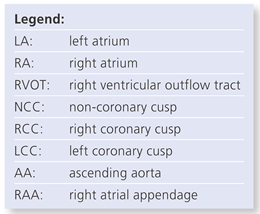
Funding/potential competing interests
No financial support and no other potential conflict of interest relevant to this article was reported.
References
- Bernabeau, E.; Mestres, C.A.; Loma-Osorio, P.; et al. Acute aortic and mitral valve regurgitation following blunt chest trauma. Int Cardiovasc Thorac Surg. 2004, 3, 189–200. [Google Scholar]
- Halstead, J.; Hosseinpour, A.R.; Wells, F.C. Conservative surgical treatment of valvular injury after blunt chest trauma. Ann Thorac Surg. 2000, 69, 766–768. [Google Scholar] [CrossRef] [PubMed]
- Pretre, R.; Chilcott, M. Blunt trauma to the heart and great vessels. N Engl J Med. 1997, 336, 626–632. [Google Scholar] [CrossRef] [PubMed]
- Banning, A.P.; Pillai, R. Non-penetrating cardiac and aortic trauma. Heart 1997, 78, 226–229. [Google Scholar] [CrossRef] [PubMed]
- Payne, D.D.; De Weese, J.A.; Mahoney, E.B.; Murphy, G.W. Surgical treatment of traumatic rupture of the normal aortic valve. Ann Thorac Surg. 1974, 17, 223–229. [Google Scholar] [CrossRef] [PubMed]
- Kan, C.-D.; Yang, Y.-J. Traumatic aortic and mitral valve injury following blunt chest injury with a variable clinical course. Heart 2005, 91, 568–570. [Google Scholar] [CrossRef] [PubMed][Green Version]
© 2011 by the author. Attribution - Non-Commercial - NoDerivatives 4.0.